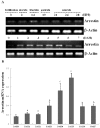Expression Analysis of Visual Arrestin gene during Ocular Development of Olive Flounder (Paralichthys olivaceus)
- PMID: 25949138
- PMCID: PMC4282292
- DOI: 10.12717/DR.2013.17.3.231
Expression Analysis of Visual Arrestin gene during Ocular Development of Olive Flounder (Paralichthys olivaceus)
Abstract
Olive flounder (Paralichthys olivaceus) is one of the commercial important flatfish species in Korea. The ocular signal transduction pathway is important in newly hatched flounders because it is closely involved in the initial feeding phase thus essential for survival during the juvenile period. However, the study of gene expression during ocular development is incomplete in olive flounder. Therefore we examined the expression analysis of specifically induced genes during the development of the visual system in newly hatched flounders. We searched ocular development-involved gene in the database of expressed sequence tags (ESTs) from olive flounder eye and this gene similar to arrestin with a partial sequence homology. Microscopic observation of retinal formation corresponded with the time of expression of the arrestin gene in the developmental stage. These results suggest that arrestin plays a vital role in the visual signal transduction pathway of the retina during ocular development. The expression of arrestin was strong in the ocular system during the entirety of the development stages. Our findings regarding arrestin have important implications with respect to its biological role and evolution of G-protein coupled receptor (GPCR) signaling in olive flounder. Further studies are required on the GPCR-mediated signaling pathway and to decipher the functional role of arrestin.
Keywords: Arrestin; GPCR signaling; Gene expression; Ocular development; Olive flounder..
Figures




Similar articles
-
Expression of Perforin Gene for Early Development of Nephrons in Olive Flounder (Paralichthys olivaceus).Dev Reprod. 2013 Dec;17(4):321-7. doi: 10.12717/DR.2013.17.4.321. Dev Reprod. 2013. PMID: 25949147 Free PMC article.
-
Expression of Vimentin Intermediate Filament for Vascular Development in Olive Flounder (Paralichthys olivaceus).Dev Reprod. 2014 Jun;18(2):107-15. doi: 10.12717/DR.2014.18.2.107. Dev Reprod. 2014. PMID: 25949178 Free PMC article.
-
Differential Expression Patterns of Crystallin Genes during Ocular Development of Olive Flounder (Paralichthys olivaceus).Dev Reprod. 2012 Dec;16(4):301-7. doi: 10.12717/DR.2012.16.4.301. Dev Reprod. 2012. PMID: 25949104 Free PMC article.
-
Expression Pattern of Early Growth Response Gene 1 during Olive Flounder (Paralichthys olivaceus) Embryonic Development.Dev Reprod. 2014 Dec;18(4):233-240. doi: 10.12717/DR.2014.18.4.233. Dev Reprod. 2014. PMID: 32885106 Free PMC article.
-
Expression Pattern of Early Growth Response Gene 1 during Olive Flounder (Paralichthys olivaceus) Embryonic Development.Dev Reprod. 2014 Dec;18(4):233-40. doi: 10.12717/devrep.2014.18.4.233. Dev Reprod. 2014. PMID: 25949193 Free PMC article.
References
-
- Attramadal H, Arriza JL, Aoki C, Dawson TM, Codina J, Kwatra MM, Snyder SH, Caron MG, Lefkowitz RJ. Beta-arrestin2, a novel member of the arrestin/beta-arrestin gene family. J Biol Chem. 1992;267:17882–17890. - PubMed
-
- Bohn LM, Lefkowitz RJ, Gainetdinov RR, Peppel K, Caron MG, Lin FT. Enhanced morphine analgesia in mice lacking beta-arrestin 2. Science. 1999;286:2495–2498. - PubMed
-
- Burns ME, Arshavsky VY. Beyond counting photons: trials and trends in vertebrate visual transduction. Neuron. 2005;48:387–401. - PubMed
-
- Conner DA, Mathier MA, Mortensen RM, Christe M, Vatner SF, Seidman CE, Seidman JG. beta-Arrestin1 knockout mice appear normal but demonstrate altered cardiac responses to beta-adrenergic stimulation. Circ Res. 1997;81:1021–1026. - PubMed
-
- Cook A. Ontogeny of feeding morphology and kinematics in juvenile fishes: a case study of the cottid fish Clinocottus analis. J Exp Biol. 1996;199:1961–1971. - PubMed
LinkOut - more resources
Full Text Sources
Other Literature Sources
Molecular Biology Databases

